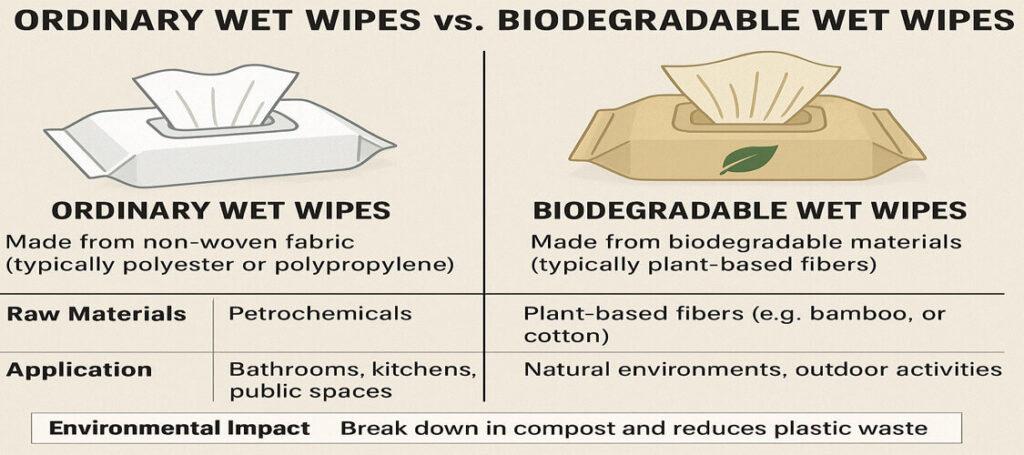Wet wipes have become a part of our daily lives—whether it’s for cleaning hands on the go, wiping down kitchen surfaces, or taking care of babies. However, with growing awareness of environmental sustainability, consumers are starting to pay more attention to what wipes are made of and how they impact the planet. The main debate now revolves around ordinary wipes and biodegradable wipes. Let’s dive deeper into their definitions, raw materials, advantages, disadvantages, and application scenarios.
1. Definitions
- Ordinary Wipes: These are traditional wet wipes made mainly from synthetic fibers such as polyester or polypropylene. They are durable, low-cost, and widely available in supermarkets and convenience stores. However, because they are petroleum-based, they do not break down easily in nature, which means they can remain in the environment for decades.
- Biodegradable Wipes: These wipes are designed with sustainability in mind. They are made from natural or plant-based fibers such as bamboo, cotton, or wood pulp (viscose/rayon). Unlike ordinary wipes, biodegradable wipes are engineered to decompose under the right conditions, reducing environmental pollution. They are usually marketed as eco-friendly alternatives for environmentally conscious consumers.
2. Raw Materials
- Ordinary Wipes:
- Polyester & Polypropylene: Non-woven synthetic fabrics made from petrochemicals.
- Blended Synthetic Fibers: Sometimes combined with small amounts of natural fibers for texture.
- Additives: Lotion, fragrance, preservatives, and moisturizing agents.
- Biodegradable Wipes:
- Bamboo Fiber: Known for its fast growth and sustainability.
- Cotton: Soft, gentle on skin, and plant-based.
- Viscose/Rayon from Wood Pulp: Derived from renewable natural resources.
- Eco-friendly Additives: Natural lotions and fewer harsh chemicals.
3. Pros and Cons
| Type | Pros | Cons |
|---|---|---|
| Ordinary Wipes | – Strong and durable- Affordable price- Wide availability in stores- Longer shelf life | – Non-biodegradable- Cause long-term pollution- Can clog sewage systems and pipes- Often contain chemicals that may irritate sensitive skin |
| Biodegradable Wipes | – Eco-friendly and compostable- Gentle on skin, suitable for babies- Reduce landfill waste- Support sustainable lifestyles | – Higher price compared to ordinary wipes- Shorter shelf life (can degrade faster in packaging)- May be less durable than synthetic wipes- Not all “biodegradable” wipes break down quickly in every environment |
4. Application Scenarios
- Ordinary Wipes:
- Daily Use: Convenient for cleaning hands, wiping down furniture, or freshening up.
- Baby Care: Affordable option for parents, though not always ideal for sensitive skin.
- Travel & Outdoor Use: Handy and durable for long trips.
- Industrial & Commercial Cleaning: Preferred for strength and low cost.
- Biodegradable Wipes:
- Eco-Conscious Households: Chosen by families who prioritize sustainability.
- Baby Care: Especially for babies with delicate or sensitive skin.
- Outdoor Activities: Safer for disposal in nature, especially during camping or hiking.
- Sustainable Brands: Increasingly used by brands that want to promote green living.
5. Environmental Impact
- Ordinary Wipes often end up in landfills or sewage systems, where they can take up to 100 years to degrade. They contribute to the growing global problem of plastic pollution, including microplastics in oceans.
- Biodegradable Wipes, on the other hand, can break down much faster (within months to a few years depending on conditions), minimizing their environmental footprint. However, not all biodegradable wipes are created equal—some only decompose under industrial composting conditions, which means proper disposal methods are still important.

6. Choosing the Right Wipe
When choosing between ordinary and biodegradable wipes, consider your budget, usage, and environmental values. Ordinary wipes may be more practical for short-term, large-scale cleaning tasks, but biodegradable wipes are a smarter choice for long-term sustainability and healthier skin contact.
